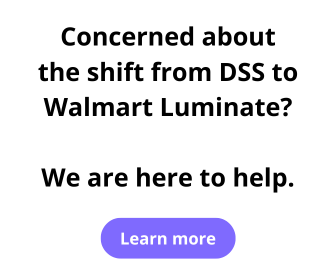Decoding Walmart's Supplier Performance Scorecard
The Supplier Performance Scorecard, also known simply as the "Scorecard" is a same page thinking document commonly used by Walmart Buyers and Replenishment Teams.
The Supplier Performance Scorecard — also known as simply the Scorecard — is a "same page thinking" document that Walmart has created to allow suppliers to view their account performance from the same perspective as Walmart. In other words, "does Walmart think the account performance is good, bad, or somewhere in between".
Understanding the dozens of metrics in the Scorecard is essential for suppliers, as this is how Walmart measures the performance of your account.
The Scorecard is part of Decision Support System (DSS), which is the application in Retail Link® where suppliers can create, save and download custom reports.
Main Components of the Supplier Scorecard
Though there are dozens of metrics on the Supplier Scorecard, they all fall within three main categories:
- Sales Volume
- Profitability
- Asset Efficiency
Sales Volume
Sales volume is a straightforward metric — how many units of your items did Walmart sell to the consumer in a given time period.
Common sales metrics include:
- Sales, units
- Sales, dollars
- Comp store sales
- Average retail sales price
Sales volume is the most commonly viewed metric by Walmart suppliers. Afterall, the entire point of selling to Walmart is for them to sell your items to the consumer! However, sales volume doesn't consider equally important metrics — like profitability.
Your items could sell very well in Walmart stores, but those sales could be a function of excessive markdowns. This means that you are selling a lot of your items to the consumer, but Walmart's profitability is less than they are expecting.
Therefore, suppliers need to consider all three metrics — sales, profitability and asset efficiency — in conjunction with each other.
Profitability
The second category of performance metrics on the Supplier Scorecard is Profitability. As the term suggests, this is an indication of how many dollars in profit Walmart realized when the consumer bought the item in stores.
Common profitability metrics include:
- Initial margin %
- Maintain margin %
- Mardown / Markup %
The addition of profitability into the Scorecard allows Walmart to view the performance of your items in terms of profit — rather than simply retail sales.
Asset Efficiency
The third category of performance metrics on the Supplier Scorecard is Asset Efficiency. This is a term used to help tell Walmart how efficiency they are handling their assets — in this case, your inventory.
Common asset efficiency metrics include:
- Unit turns
- Retail turns
- Instock %
- Weeks of supply
- GMROII - gross margin return on inventory investment
GMROII stands for Gross Margin Return on Inventory Investment. In simple terms, this tells Walmart how many dollars in gross margin did Walmart receive for every dollar of inventory that they carried at the stores.
If there is a "score" on the Supplier Scorecard, GMROII is it! This metric combines all of the other metrics into one, answering the question — does it make sense to keep this item on Walmart's shelves!
In Conclusion
Just from looking at the scorecard, you can see that there are dozens of metrics on the Scorecard over various time ranges. Walmart Buyers and Replenishment Teams review this report on a weekly basis for each of their suppliers. It should therefore be on each supplier's to-do list every Monday morning to review the Supplier Performance Scorecard, keeping an eye on the prize — GMROII.
Receive notifications of new Walmart inititives, supplier resources and educational articles — delivered to your inbox!
Additional Articles
The Supplier Performance Scorecard, also known simply as the "Scorecard" is a same page thinking document commonly used by Walmart Buyers and Replenishment Teams.
A candid discussion about the transition from Decision Support to Walmart Luminate and what it means for Walmart suppliers
